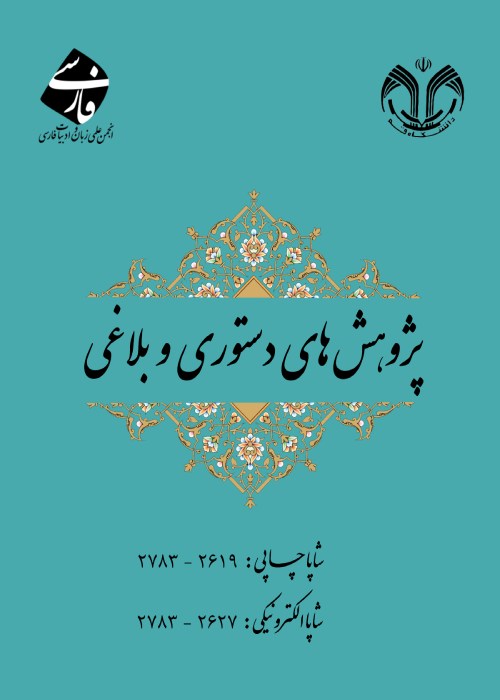Aesthetics of Pronoun in Morsal Prose based on the Jakobson's Metonymic Pole of the Language
Author(s):
Article Type:
Research/Original Article (دارای رتبه معتبر)
Abstract:
Although exterior of language in the texts of Morsal prose has been embellished and glamorized through figurative language, the essential elegance of this type of prose rests on the interior of the language, and it is achieved through the artistic arrangement of words. According to systemic functional linguistics, pronouns, due to their great flexibility, play a critical role in this embellishment. In such texts, pronouns are among the most frequent and crucial elements. Furthermore, their sliding position in the sentence structure has given them an exceptional prominence. Authors of such books like Tarikh-i Bal'ami or Tārīkhnāma and Tarikh-i Sistan (History of Sistan) achieved diverse artistic objectives by syntactical replacement of the pronouns. Therefore, Jakobson's theory of metonymic pole could equip us with an effective device to reevaluate the aesthetics of the pronouns in such texts. The aim of this article is to answer the question of how pronouns could attain such artistic and aesthetic function in conjunction with other words. Relying on the theory of the metonymic pole of language, the author of this article has closely studied Tarikh-i Sistan (History of Sistan), as one of the magnificent works of Morsal prose, using a descriptive-analytical method. The main findings of the present grammatical-rhetorical research indicates that the author of the Tarikh-i Sistan has used disconnected and connected pronouns in various forms in the beginning and the end of a sentence to create artistic language. The technique has also helped the author to obtain secondary purposes and creating literary figures of speech such as: praising, contempt, amazement, emphasis, brevity, syntactic equilibrium, Tard va Aks , Laff va Nashr ( two forms of chiasmus whereby individual elements in one line of poetry are rearranged in subsequent line), contradiction, irony, repetition as a literary figure of speech, creation of rhythmic prose, and creation of suspense. Also, along with moderate decorating of the exterior, he made the interior of the language meaningfully elegant and artistic. Seemingly; aPpreciating the rhetorical-grammatical features of pronouns in the Tarikh-i Sistan and other literary texts, as well as adopting them, could transform the tedious and sedentary nature of current pronouns and expand the literary capacity of contemporary Farsi language.
Keywords:
Language:
Persian
Published:
نشریه پژوهش های دستوری و بلاغی, Volume:11 Issue: 19, 2021
Pages:
307 to 332
magiran.com/p2311230
دانلود و مطالعه متن این مقاله با یکی از روشهای زیر امکان پذیر است:
اشتراک شخصی
با عضویت و پرداخت آنلاین حق اشتراک یکساله به مبلغ 1,390,000ريال میتوانید 70 عنوان مطلب دانلود کنید!
اشتراک سازمانی
به کتابخانه دانشگاه یا محل کار خود پیشنهاد کنید تا اشتراک سازمانی این پایگاه را برای دسترسی نامحدود همه کاربران به متن مطالب تهیه نمایند!
توجه!
- حق عضویت دریافتی صرف حمایت از نشریات عضو و نگهداری، تکمیل و توسعه مگیران میشود.
- پرداخت حق اشتراک و دانلود مقالات اجازه بازنشر آن در سایر رسانههای چاپی و دیجیتال را به کاربر نمیدهد.
In order to view content subscription is required
Personal subscription
Subscribe magiran.com for 70 € euros via PayPal and download 70 articles during a year.
Organization subscription
Please contact us to subscribe your university or library for unlimited access!



